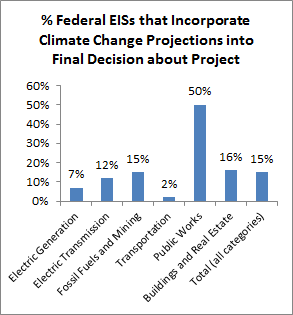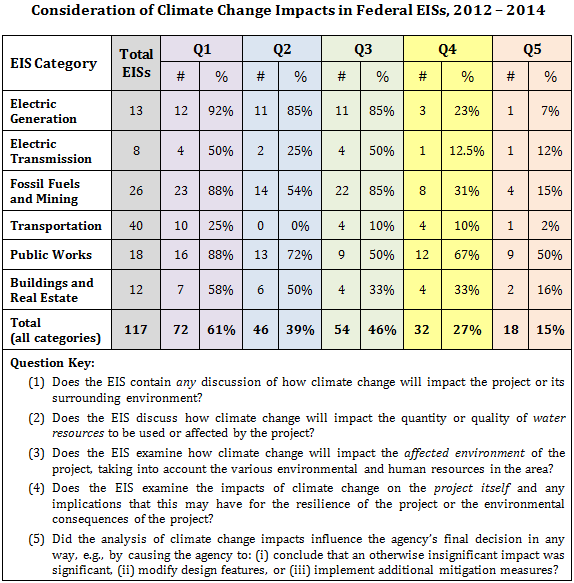 Jessica Wentz
Jessica Wentz
Associate Director and Postdoctoral Fellow
Although it has become more common for agencies in preparing environmental impact statements (EISs) to acknowledge the impacts of climate change on a project and its affected environment, it is still quite rare for agencies to accurately incorporate this knowledge into final decisions about the project design, selection of alternatives, or mitigation measures. Only 15% of the EISs indicated that these considerations influenced final decisions about how to proceed with the project.
This is a key finding of a survey of how climate change impacts and adaptation considerations were addressed in federal EISs published between 2012 and 2014. The survey included 117 EISs for proposals involving electric generation and transmission, energy development and mining, transportation, water management, urban planning, and public infrastructure projects.[1]
The survey was conducted by the Sabin Center for Climate Change Law in conjunction with a report it published last month recommending that agencies use existing Environmental Impact Assessment (EIA) procedures to assess the risks of climate change in the context of proposed infrastructure and building projects.
The survey found substantial variation in the scope and depth of the analysis of climate change impacts, both within and across different project categories. Whereas 92% of EISs in the electric generation category included some discussion of how climate change may impact the project or its surrounding environment, only 25% of transportation sector EISs discussed this topic (and only 2% of the EISs indicated that the analysis of climate change impacts had any bearing on final decisions about the location or design of transportation infrastructure). The full results of the survey are summarized in the table, after the jump.
 Interestingly, one frequently cited justification for ignoring the impacts of climate change on a project and its surrounding environment was that the project would not generate a significant level of GHG emissions.[2] Thus, some agencies assumed that climate change impacts need only be addressed insofar as the project would contribute to climate change—but as explained in our paper, the National Environmental Policy Act (NEPA) and other EIA statutes require agencies to account for future environmental conditions when conducting environmental reviews, and thus the impact of climate change on those conditions should be considered regardless of whether the project generates GHG emissions.
Interestingly, one frequently cited justification for ignoring the impacts of climate change on a project and its surrounding environment was that the project would not generate a significant level of GHG emissions.[2] Thus, some agencies assumed that climate change impacts need only be addressed insofar as the project would contribute to climate change—but as explained in our paper, the National Environmental Policy Act (NEPA) and other EIA statutes require agencies to account for future environmental conditions when conducting environmental reviews, and thus the impact of climate change on those conditions should be considered regardless of whether the project generates GHG emissions.
In some EISs, it also appeared that there was confusion about the difference between evaluating the contribution of a project to climate change and evaluating the impacts of climate change on the project. For example, in response to an EPA request to “evaluate climate change effects on” a proposed dam modification, the US Army Corps of Engineers (USACE) responded: “The proposed project’s impact on greenhouse gas emissions on climate change was evaluated in the DEIS. It is located in section 3.5 – Air Quality, in the DEIS.”[3] However, as noted below, USACE has also done an excellent job of incorporating climate impact considerations into other EISs, and the agency did include at least some discussion of climate change impacts in most of the EISs that were surveyed.
The survey also revealed some positive developments. For example, 50% of EISs in the “public works” category (which primarily consisted of water management projects) indicated that climate change impact considerations had influenced the final decision about how to proceed with the project. And perhaps most promising, there were EISs spanning a variety of project categories that contained an in-depth examination of climate change impacts and adaptation options. These EISs demonstrate that it is technically feasible to use EIA as a vehicle for adapting public infrastructure to the future effects of climate change, and they could be used as a model for future environmental reviews. Some exemplary EISs include:
Arkansas Valley Conduit FEIS (2013) – A proposal for a water supply pipeline in the Arkansas River Basin, consisting of over 200 miles of buried pipeline, a water treatment facility, and other related infrastructure. The EIS considers the impact of climate change on the operation of the project and all reasonable alternatives, as well as the impact of climate change on each aspect of the affected environment. The U.S. Bureau of Reclamation was the lead agency.
Cloverdale Rancheria Casino FEIS (2014) – A proposal for development of a resort Casino in California. The EIS addressed how climate change would impact significance determinations for the preferred alternative and all other alternatives discussed in the EIS, and identified mitigation measures as needed to address any potentially significant impacts. The EIS was prepared under both NEPA and the California Environmental Quality Act (CEQA). The U.S. Bureau of Indian Affairs was the lead federal agency.
Halletts Point Rezoning FEIS (2013) – A proposal for a mixed-use development in New York. The EIS contained a detailed discussion of how sea level rise and flooding may impact the waterfront development and possible risk mitigation measures. The EIS was prepared under NEPA, the New York State Environmental Quality Review Act (SEQRA) and the New York City Environmental Quality Review Act (CEQR). The U.S. Department of Housing and Urban Development was the lead federal agency.
Keystone XL Project, Final Supplemental EIS (2014) – A proposal for a 875-mile pipeline to transport imported crude oil from Canada. Chapter 4 contained a section dedicated to evaluating climate change impacts on the construction and operation of the pipeline, with a detailed analysis of such impacts under three different emissions scenarios. The U.S. Department of State was the lead agency.
Suncreek Specific Plan FEIS (2012) – A proposal for a mixed-use development project in California. The EIS contained a detailed assessment of multiple climate impacts and potential implications for the environmental consequences of the project. The EIS was prepared under both NEPA and CEQA. USACE was the lead agency.
Tarmac King Road Limestone Mine FEIS (2013) – A proposal for a limestone mine about 80 miles north of Tampa, Florida. The EIS contained a detailed discussion of how sea level rise may impact the project based on four different sea level rise scenarios, as well as a mitigation plan with specific measures to address the impacts of climate change on the surrounding environment (e.g., by providing “replacement habitat for salt marsh and coastal hydric hammock in the event of continued climate change and sea level rise”). USACE was the lead agency.
For a detailed discussion of how these EISs addressed climate impact considerations, as well as excerpted sections for the EISs, see pp. 40-42 and Appendix B of the full report.
Our findings correspond with other assessments of how federal agencies are responding to climate change. For example, the Congressional Research Search published an analysis of federal adaptation plans and activities earlier this year, which concluded that “few examples are apparent of day-to-day agency decisions or actions that are different as a result of their adaptation efforts.” The General Accounting Office (GAO) also released a 2015 report finding that “government-wide improvement is needed to reduce fiscal exposure” to the impacts of climate change. In particular, the report found that the federal government had not fully achieved any of the GAO criteria for ensuring that federal infrastructure is more resilient to the impacts of climate change.[4]
To promote a more systematic approach to evaluating climate-related risks and adaptation opportunities on a project-specific basis, the report published by the Sabin Center included a set of model protocols for addressing climate change impacts through EIA. While the protocols use NEPA language, they could also be adapted for use under state EIA laws.
The Sabin Center also conducted a more comprehensive survey of federal EISs prepared in the same period (2012-2014), which encompasses a larger selection of projects, including natural resource and land management projects, and tracks considerations relating to both climate change mitigation and adaptation. The results of that survey are currently being compiled into a report, which will be published on our website and announced on this blog.
[1] This was an update to a previous survey of Federal EISs prepared between January 2009 and July 2012, which is available here.
[2] See, e.g., U.S. Department of Energy, Final Champlain Hudson Power Express EIS 5-188 – 5-189 (2014) (“At present, there is no methodology that would allow DOE to estimate the specific impacts (if any) this increment of climate change would produce near the proposed CHPE Project or elsewhere”).
[3] U.S. Army Corps of Engineers, Isabella Lake Dam Safety Modification Project, To Remediate Seismic, Seepage, and Hydrologic Deficiencies in the Main Dam, Spillway and Auxiliary Dam FEIS A-17 (2012).
[4] With respect to the government’s role as an owner and operator of costly infrastructure, the report found that the federal government had “partially met” criteria relating to leadership commitment, capacity, and action plans, but that it had “not met” criteria for monitoring and demonstrating progress.



